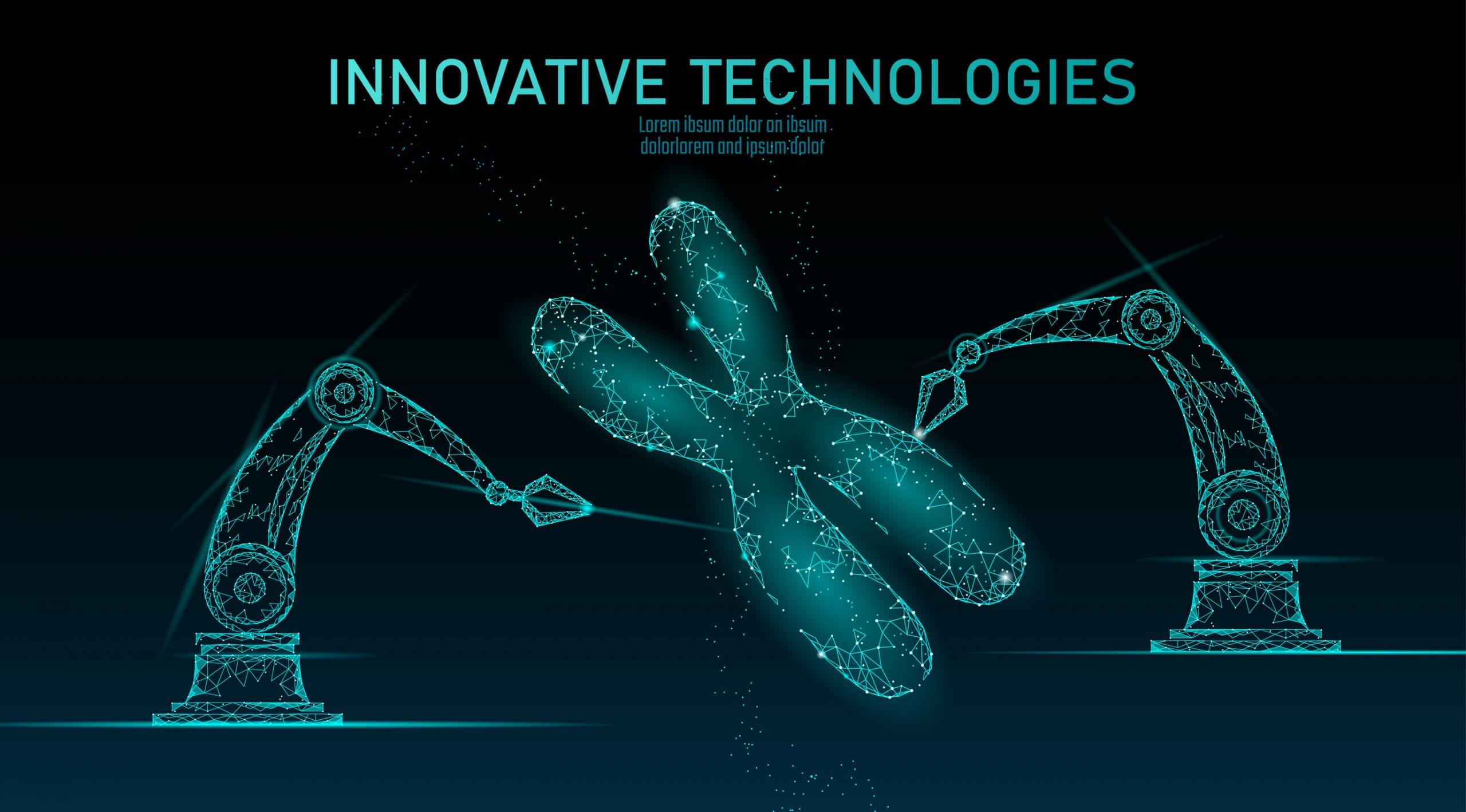Top 5 News from the World of CRISPR Gene Editing
By Rajaneesh K. Gopinath, Ph.D.
One must have been totally cut off from the scientific world to be unaware of the gene editing revolution that is upon us. CRISPR/Cas9 was first identified in bacteria and archaea as an intricately evolved adaptive immune system that archives invading viral DNA fragments from earlier encounters. In the event of a repeat infection, the archive is referred to for a match and the stored sequence get expressed. The resulting RNA guides a Cas9 endonuclease protein (and hence the name guide RNA) to cleave the region where it bound to the foreign DNA by complementary base pairing. This system was quickly adapted for genome-editing endeavors in various model organisms including humans since all it takes is a simple guide RNA and Cas9 protein to edit genomes. However, the system still needs to be perfected as many investigations report off-target effects. Nevertheless, the CRISPR boom has heralded a new era that witnesses scientific and medical wonders, patent wars and controversies day in and day out. Here is a list of the top headlines from the field.
University of California bags a fourth CRISPR patent
On the 23rd of April, U.S. Patent and Trademark Office (USPTO) issued U.S. Patent Number 10,266,850 to Jennifer Doudna of UC Berkeley, Emmanuelle Charpentier and the University of Vienna. Notably, this patent grants the use of CRISPR/Cas9 systems in a single guide format to target, edit or modulate genes in any cellular or non-cellular environment, meaning that it could be used in vitro, plants, animals and humans.
This patent was previously involved in a terminated interference proceeding involving patents from the Broad institute that focused on the use of CRISPR in eukaryotes. After a lengthy legal battle, both the PTAB and the US court of appeals ruled that the patents do not interfere and the Broad institute get to keep theirs. This is the fourth CRISPR patent received by the University of California and is set to receive three more in the near future.
“We are very pleased at the progress we’re making with the issuance of this patent and will continue to promote the intellectual property of the Doudna-Charpentier team’s CRISP/Cas9 invention,” said Eldora L. Ellison, Ph.D., lead patent strategist on CRISPR matters for UC and a Director at Sterne, Kessler, Goldstein & Fox. “Today’s patent further builds on the numerous CRISPR/Cas9 applications in UC’s portfolio and will support the university’s commitment to utilizing the genome editing technology for the benefit of our society.”
Cas9 functions in stealth mode
Among the CRISPR/Cas9 gene editing techniques used in higher eukaryotes, the most commonly used Cas9 orthologs are from Staphylococcus aureus and Streptococcus pyogenes. Recently a report found that humans exhibit humoral immunity to both these Cas9 enzymes due to the fact that these two are derived from human pathogens. Therefore, it cast doubt over using this system in human trials.
As a solution to this problem, scientists from Arizona State University (ASU) conducted a study in which the immunodominant epitopes on the Cas9 enzyme were identified and immunosilenced by mutations. The authors led by Prof. Karen S. Anderson altered the epitopes on the enzymes to render them unrecognizable by the T cells in the human body, but still maintaining its function and specificity. This could be an effective strategy to make Cas9 safe to be employed in humans. The study results were published in Nature communications on the 23rd of April.

CRISPR used for the first time in human immunotherapy trials in the US
Last November, Chinese scientist, He Jiankui caused a big furor by announcing his creation of “CRISPR babies” at an International Summit. He created a controversy by employing CRISPR to edit genes in human embryos sparking a global outcry on unethical practices. This led to many prominent scientists calling for “a global moratorium on all clinical uses of human germline editing”. The major criticism was over the fact that the implementation of the technology was premature and editing at the level of germline carries the risk of unintended off-target mutations becoming heritable.
However, on the 16th of April, the National Public Radio reported a case in which CRISPR editing was approved in humans. A phase I clinical trial, testing cancer immunotherapy was underway in humans at the University of Pennsylvania in Philadelphia. The trial was conducted in two cancer patients treated for myeloma and sarcoma. It involved the engineering of autologous T Cells to express a recombinant T cell receptor (TCR) while the endogenous TCR and PD-1 were eliminated using CRISPR/Cas9 gene editing. This is the first time the CRISPR technology has used in human subjects in the US.
Off-target RNA editing by CRISPR guided DNA base editors
Off-target effects prove to be a major hindrance in employing the CRISPR/Cas9 technology. Reiterating that point, a study published in Nature by a research group from Massachusetts General Hospital (MGH) demonstrated that the CRISPR base editors which efficiently induces single nucleotide changes in DNA, also induces transcriptome-wide off-target effects in the RNA. The authors explored whether this undesired effect could be reduced by screening around 16 base editors with engineered versions of the deaminase enzymes. Two of the 16 were found to cause fewer RNA edits while their DNA editing capacity was intact.
DISCOVER-Seq method to prevent off-target effects
In a bid to minimize off-target effects, a team from the Gladstone Institutes and the Innovative Genomics Institute (IGI), along with collaborators at AstraZeneca, have developed a method to prevent off- target effects. “When CRISPR makes a cut, the DNA is broken,” says Beeke Wienert, PhD, who is one of the co-first authors of the study. “So, in order to survive, the cell recruits many different DNA repair factors to that particular site in the genome to fix the break and join the cut ends back together. We thought that if we could find the locations of these DNA repair factors, we could identify the sites that have been cut by CRISPR.”
Among an array of DNA repair factors, the authors found MRE11 to be one of the first proteins to be recruited to the site of the cut. They developed a new technique known as DISCOVER-Seq to map the exact sites in the genome where a cut has been made. “When we want to cut DNA with CRISPR, it’s like we’re trying to remove one specific word on a particular page in that novel. You can think of the DNA repair factors as different types of bookmarks added to the book,” Conklin adds. “While some may bookmark an entire chapter, MRE11 is a bookmark that drills down to the exact letter than has been changed.”
References
1. https://news.berkeley.edu/2019/04/23/uc-issued-fourth-crispr-patent-three-more-on-the-way/
2. https://www.nature.com/articles/s41591-018-0326-x
3. https://www.nature.com/articles/s41467-019-09693-x
4. https://www.npr.org/sections/health-shots/2019/04/16/712402435/first-u-s-patients-treated-with-crispr-as-gene-editing-human-trials-get-underway
5. https://www.nature.com/articles/s41586-019-1161-z
6. https://gladstone.org/about-us/news/new-method-detect-off-target-effects-crispr
©www.geneonline.com All rights reserved. Collaborate with us: service@geneonlineasia.com









